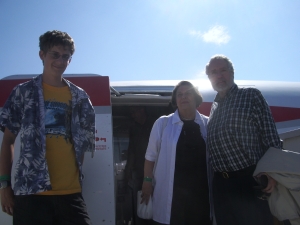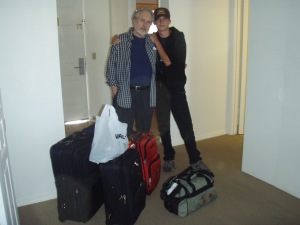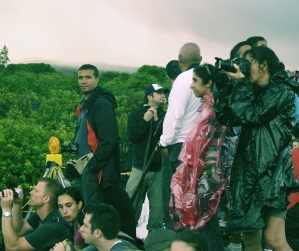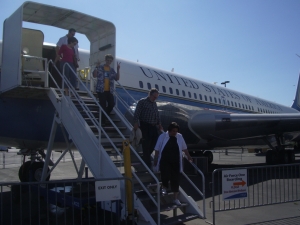What Do I Take When I Go To Hawaii?
Packing Your Bags for Hawaii: With airlines charging for a second--or even for the first--piece of luggage, and strict "50 pounds each" weight limits being enforced, the thrifty traveler is wise to plan ahead carefully, to avoid racking-up expensive fees. I used to travel by the motto "Don't check baggage unless you can afford to lose it; if you can afford to loose it, why did you bring it?"; thus I never traveled with anything more than carry-on. While it is always good to travel lightly, with the advent of stringent new carry-on limits and my advancing age (and concomitant increasing desire to travel in comfort) I have learned to travel with only one piece of checked baggage plus carry-on. The key is packing intelligently so you can pack less.
Be Smart About Your Carry On Baggage: Most airlines allow you to bring one carry-on bag and a personal item such as a purse or a lap-top. I push this a little by bringing a carry-on bag plus my lap-top in a computer pack which also has room for one video camera, my SLR Camera and an emergency change of clothes (in case all my other luggage is lost). Usually they let me get away with this. Because I trust neither baggage handlers nor TSA inspectors and my luggage has been lost more times than I remember, I pack my other cameras and the majority of my clothes in my other carry on bag so they don't have to be checked. In this bag I also carry a quart of water and some snacks.
You'll want at least one book to read on the flight; your tickets, reservation confirmations, travelers checks, list of phone numbers, spare glasses (contacts and solution) and medications should be put in a water-proof bag in the carry-on bag you intend to hold most tightly to.
Remember that more books, extra batteries, memory cards, video tape or film, masks-fins-snorkels, insect repellant, sun cream, beach towels--all the extra hoopla one might want on a Hawaii vacation--can be purchased at WalMart or Costco on-island as cheaply as the mainland. If you do pack film, and it is in your carry-on, be sure to protect it against x-rays.
Checked Luggage; First, Plan for Your Activities: Know your itinerary and pack only what you need; resist the temptation to toss in all those extra unnecessary items. You may be planning on some particular activities in Hawaii requiring specific gear or clothing--it is best to think this through thoroughly. Many people intend to save money by bringing their own snorkeling gear. This is false economy if it causes you to pay for additional luggage. Buying snorkel gear on island is fairly inexpensive and renting is faster, easier and even cheaper. The same can be said of renting diving gear and golf clubs. Activities such as hiking and horseback riding require a fairly specific wardrobe, but if you plan correctly, you only have to bring your hiking/riding boots and an extra pair of suitable pants and shirt. If you plan on visiting the mountain summits, remember that they can be quite cold--even snowy or rainy--so plan and pack accordingly. If you bring boots, I advise wearing them (and all your other bulky clothing) on the plane to save room and weight in your bags. As for photography gear or musical instruments--any expensive or delicate equipment for that matter--my philosophy is to never turn loose with it. Never check your cameras, your guitar, your laptop, etc--it's a recipe for theft, loss or destruction.

- You Need More Suntan Lotion Than You Think...Put it on Before You Go Out in the Sun and Keep Putting It On Throughout The Day. Likewise, Drink More Water Than You Think You Need...Drink Before You Get Thirsty, When You Get Thirsty and Drink Again After You've Just Had Some Water. No, Drink Some More--I'm Serious: Photo By Donnie MacGowan
Next, Plan for the Weather: Being tropical, temperatures at sea level in Hawaii vary only by about 10 degrees between day and night and throughout the year. It's hot during the day, plan a cool wardrobe. The windward side is generally rainy and the "up-country" towns (mountains) frequently can experience afternoon showers. Evenings, particularly up-country, are delightfully cool as there is generally an evening or onshore breeze. With forethought, your wardrobe can cover all these situations without being bulky, heavy or ornate. Remember to pack layers of clothing for warmth, rather than one or two bulky coats and sweaters-this allows for maximum adaptability and a certain amount of built-in variability. This also means that if an emergency hotel-room laundry session is required, your laundry will dry much more quickly.
Finally, Specifics: Be efficient--coordinate around a basic, neutral color so everything you bring matches everything else. Black or khaki are the traditional traveler's choices. Dark colors show dirt less than light colors, and this can be a saving grace where doing laundry is impractical. Choose clothes for lightness, packability and washability. Remember that suits in Hawaii are unnecessary; even Circuit Court judges wear Aloha Shirts under their robes here. A nice shirt, generally an Aloha Shirt, and a pair of khakis are the wardrobe of choice at the finer restaurants and nightclubs--everywhere else, it's shorts and sandals. I would advise a basic wardrobe consisting of a polo-style shirt and a couple Aloha Shirts, one pair of long khakis and three pair of shorts, a swimsuit, a couple tank tops or t-shirts, a sunhat and a light jacket for evenings; that's all you really need to cover most bases. Women may want to toss in a light sundress or skirt. Sandals are all you'll need or want in the way of footwear (your feet will be HOT)--you may want to toss in a pair of running shoes for exercise or hiking. Unless you are attending a formal event such as a wedding, don't worry about dressing up or you will not only find yourself carting far too much luggage, but awkwardly overdressed as well.
Be thoughtful about your wardrobe and activities: for instance, you may wish to think about bringing two swimsuits--you will be amazed how pleasant being in the water is in the hot tropics. Whether you are just cooling off in the pool or snorkeling with the turtles and fish, you'll probably want to swim everyday. Swimsuits rarely dry overnight and it's a lot more pleasant to get into a warm, dry suit than a wet, cold one. Also, if you plan on riding horseback or exploring the higher elevations such as Hawaii Volcanoes National Park or Mauna Kea, be sure to bring some jeans and appropriate footwear, a medium weight fleece sweater and light rain jacket/windbreaker. A compact traveler's umbrella is always a good idea.
Don't forget to pack your toiletries and personal items; I used to carry these on, in case of lost luggage, but restrictions on liquids and gels and razors make this impractical. Medications, of course, go in the carry-on. Sun block, sun hat, sunglasses and sun-burn cream (I use an aloe gel) will make your vacation smoother, but can be purchased cheaply locally if you don't quite have room for them.
Other Things to Bring: Just as an aside, two things you need to be head's up about when you are in Hawaii--if you begin to feel thirsty, you've waited too long to get a drink of water; if you begin to feel the sun, you've waited too long to put sun block on. Drink more water than you think you need, apply sun block before you go out and re-apply more often that you think you need. Your body is used to more moderate climates and won't warn you in time of the danger. In fact, sometimes it's dry enough on the leeward side that you won't even feel yourself sweat—it evaporates before you get wet. So remember to keep drinking water—alcohol, coffee and ice tea (as well as caffeinated sodas) are both diuretic and vasodilatory, so are counterproductive to keeping hydrated. Drink water. Lots and lots of water. Although bottled water is abundantly available, being a thrifty traveller, I always bring my own reusable water bottles. These may be carried on, but you need to take them through Security Screening empty, filling them at a water fountain before boarding—this also allows you to have water to drink during the flight, remembering that tap water on some airlines has proven to be unsafe.
Many people plan ahead by leaving ample room in their luggage to bring back souvenirs and gifts; recent luggage restrictions are making this impractical. Rather than buying new outfits for my trip, I spend the week before my trip weeding through my wardrobe, packing one very nice set of clothes and the remainder are items that were already bound for the thrift store. Thus, I simply abandon them at the end of my stay and thereby have more than enough space in my luggage for anything I buy. Remember—Hawaii is part of the US and the U.S. Postal Service sells flat-rate, pre-paid, boxes for very inexpensive rates. Ask for "Flat Rate Shipping Boxes" and ship those gifts home safely, cheaply and with no fuss on your part.
You should toss in a small fanny pack or day-pack for day trips...it's amazing how many things you find you need to carry around during the day (sunscreen, water bottles, guidebook, camera, small purchases) and a pack helps to keep them organized and in hand. A small pack can also double as a laundry bag on the flight home.
Although this is not the time for a discussion of vacation photography in general, let me say a few words about cameras. This is Hawaii for pete's sake, one of the most beautiful places on earth! You are going to want to take pictures while you are here, you are going to wish you had taken pictures all the long years down the road after you return. You do not have to be like me, packing two video cameras, a digital SLR and a digital underwater camera; even if you are not camera savvy at all, there are easy alternatives.
Simplest by far, and not terribly expensive, are pre-loaded, disposable film cameras. Available for $5-10 each, and costing about the same for film developing, these are the most basic point-shoot-enjoy photographic choice. There are even disposable underwater cameras if you plan on any swimming, kayaking or snorkeling. May I suggest that you have your film developed in Hawaii—WalMart, KMart and Costco all have 1-2 hour processing at reasonable prices. The color balance in Hawaii, because of its equatorial position (angle of sun and thickness of atmosphere) and the richness of the colors of flora, land and sea, is different to what most film-processing shops know and thus, if you wait until you return home to develop the film, the colors will turn our disappointingly. Getting your film processed on island also allows you to share prints with people you meet or are visiting.
Digital cameras may at first seem confusing, but are really much easier to deal with than film cameras, have such great storage capacity that they quickly pay for themselves in film and processing costs and produce images that, even for the rank beginner, are startling and gorgeous. You don't even need a computer to enjoy your digital pictures, just take them to any film processing shop and they'll make prints for you—much more cheaply than prints from film. If you plan to buy a digital camera for the trip, or are not quite used to the one you have, start practicing with it about a month before you leave...standing with your arm around your lover in the perfect sunset, with the palm trees swaying, the hula girls dancing on the beach and the humpback whales leaping in the ocean (oh, yes, these scenes DO happen!) is not the time to be fiddling with camera and instruction booklet trying to figure out how the damn thing works. Secondly, be sure to bring that instruction book, all accessory cords, chargers and adapters in a small plastic baggie when you come—they are expensive to buy on vacation and you never know what you'll need. Experience will teach what you can leave behind on successive trips. If buying a new digital camera to immortalize your trip to Paradise, think about getting a waterproof version. Most major camera manufacturers produce fine, submersible cameras, good to 40 feet or so, that are every bit as good as the regular cameras and are not very much more expensive. Many also have video features that allow you to take brief video clips, even underwater. One final note on your camera—never let go of it. Keep it in your carry-on bag during the flight, in your pocket or you day pack on the trip, do not leave it in your rental car or your hotel room or lunch table. Ever.
Finally, one of the most enduring visions I have of travel is standing exhausted, late night at the luggage carousel as hordes of weary travelers lift first one anonymous piece of black luggage, then the next, searching for their own amongst a sea of ubiquitous black nylon and leather travel bags. Not everyone is comfortable carrying the bright Hawaiian print luggage I have (although I always instantly recognize my bags...except when returning to Hawaii where EVERYBODY has this luggage), but there are ways to customize and personalize your bags. One of the more common, and therefore useless, is the nylon rainbow-colored strap...there are almost as many of these wrapped around the anonymous black luggage as there are plain black bags themselves. Airlines don't like straps and cords flopping around off the luggage, for obvious reasons, but you can buy colorful and unique baggage tags or tie a bit of uniquely colored ribbon or a small scarf to the handle of your luggage...just something that screams “Mine!” to you as it slides down onto the carousel so you do not have to search plaintively through the weary lot of black bags with rainbow belts on them.
This is Hawaii, remember? You came to have fun!
For more information on traveling to Hawaii in general, or touring the Big Island in particular, please also visit www.tourguidehawaii.com and www.lovingthebigisland.wordpress.com. Information about the author can be found here.
All media copyright 2009 by Donald B. MacGowan








No comments:
Post a Comment